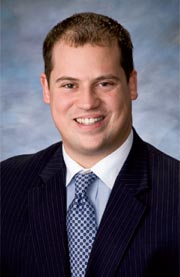|
Agency partners: Wellness done right
HealthCheck360 focuses on performance and accountability
By Michael J. Moody, MBA, ARM
The rising cost of health care has been at the top of corporate America’s list of concerns for quite some time now. At the time this article is being written, Congress is struggling to reach some consensus as to how to solve this long-standing problem. Many in Washington have said that a compromise bill will be passed by Congress by the end of the year, but I would not want to bet the farm on that. There are just too many diverse interests involved in this complicated issue.
Regardless of how—or even when—Congress will act on this matter, this issue continues to dominate the corporate world. A recent survey of CFOs conducted by Grant Thornton shows the magnitude of the problem. Of the 846 survey participants, 77% pointed to benefit cost pressures as their greatest concerns. The next closest issue was cost of energy, and raw materials (rated at 30%) and the cost of insurance, also at 30%. Clearly, corporate America realizes the importance of getting health care costs under control.
Wellness programs
But most employers realize that it is not just lowering the expense factors of their health insurance plans that is the answer. If that would work, we would have solved this problem decades ago. They now know that we have to also change the health choices that our employees are making. This is where the real savings are going to occur. This is the area that President Obama is talking about when he refers to “bending the curve.” We have to begin to do a better job of helping our employees become accountable for making better, healthier decisions about their lifestyles.
One of the initiatives that has been promoted recently is “wellness programs.” While wellness is not really a new idea—it has been around for the past 20 years or so, it has recently become the new buzzword within many employee benefit departments, as they look for ways to improve the results of their organizations’ escalating health care costs. However, for the most part, wellness programs have generally not lived up to their advanced billings. While there are any number of reasons for their shortcomings, one of the most obvious is the lack of tangible results. Traditionally, any financial results have been subjective and based on anecdotal evidence. And while these types of programs could survive in the past, today, corporations are looking for concrete evidence before adopting any expenditures. Most health care experts agree that wellness programs need to move to the next level where documented results could be provided.
Paradigm shift
According to Michael Kelly, director, Health & Wellness Services at HealthCheck360° (360°): “Our vision of wellness is more like the innovations that have occurred in risk management, than traditional wellness programs. In that regard, we treat health risk management the same way employer groups have treated safety programs; identify the root causes of claims and attack those instead of waiting for claims to occur.”
As a result, he notes, “We have been able to create a tool set that instead of waiting for claims to hit, we are proactively indentifying health risks on an individual and group level, so we can shape and focus programming on the specific needs of the employers. But, more important, on the individual/employee side, we are providing education, awareness and the motivation to change.” All of these are important, says Kelly, “to help employees make better decisions on their life style; but to integrate the motivational aspect into the program has led to in excess of 75% participation rates across our book of business and has driven real behavior change.”
All well and good, but what makes 360° so innovative? “That is easy,” says Kelly, “We have created a program that centers around performance-based outcomes. Our clients demand performance and measurable outcomes in every aspect of their business. Why should employee benefit plans be treated differently?”
David Becker, president of Dubuque, Iowa-based Cottingham & Butler, the 2007 Rough Notes Marketing Agency of the Year, recommended 360° as an Agency Partner. He points out: “The cornerstone of the 360° wellness program is the biometric health risk assessment.” This assessment provides objectively scored data that comes from the blood work and the subsequent measurements that are an integral part of the 360° program. Becker notes this is in sharp contrast to most wellness programs that tend to work with subjective outcomes, where employees frequently “game” the system.
Kelly adds, “Having an objective scoring system based on modifiable health risks gives our program the ability to integrate with meaningful incentive programs, all types of benefit design, and the data can be provided to other health management programs to provide value.”
History has shown that from a psychological standpoint, a small percentage of people will make changes if they receive the correct level of education. Kelly says, “All of our participants receive comprehensive, individually-scored reports that provide a true picture of their health risks and how to change them, including recommended levels, types of changes needed, etc.” He notes, “For many participants, the identification of latent health risks is enough to make healthy changes, but for most in our employer population this isn’t enough.” Unfortunately, a larger percentage of people, even if you put good information in front of them, don’t take action. “That is just a fact,” Kelly points out.
And he notes, “We specifically designed our Health Risk Assessment and coaching programs to allow employers and consultants the ability to integrate and design meaningful incentives (i.e., employee contributions based on the outcomes of the wellness programs.)” At the end of the day, Kelly says, “Incentive-based premiums provide a greater motivation than any other incentives in the marketplace for employees to make needed health changes.”
The 360° program includes a full-service health coaching aspect that is designed to help high-risk employees make positive changes. Kelly says, “We all know that when a person is trying to learn a new routine it is pretty easy to fall off the path and, at that point, you just need someone there to help you. And we are there to give the right feedback so as to produce the right changes. Unlike a lot of wellness programs which specialize in sending flyers out every couple of weeks, 360° is more hard-edged.”
From the employer’s standpoint, the program focuses on putting the company’s money into things that actually generate real outcomes. And from the employee standpoint, Kelly indicates, “If people don’t get better, they don’t get the incentives.” He says, “It is as simple as that.”
Proof is in the pudding
According to Becker, Cottingham & Butler has been a demonstration site for the development of the 360° program. Becker points out that they have been able to show tangible results, “by drinking the Kool-Aid.” He notes that reviewing the program from the first year to the second year, “we were able to provide some interesting results.” For example, the agency looked at the high-risk individuals, (i.e., those with high blood pressure, overweight, etc.) and found that about 60% of those high-risk people made a positive lifestyle change. Becker says, “The average obese person lost 13 pounds from one year to the next.” Even more amazing, Becker notes that 60% of the people who had high blood pressure were in the normal range the next year.
Becker says that Cottingham & Butler has always been concerned about impact of the high-risk employees on the overall health costs. He notes that over the past seven years, “for those people we consider healthy, their health insurance premiums have increased only an average of 2%.” And by using HealthCheck360°, he says, “First we see real health changes, then we are seeing that translate into real financial savings.” At the CEO/CFO level, the wellness/health risk management program must be able to track and report the impact of the program from year to year. And this is one of the important features that HealthCheck360° is able to do.
Conclusion
There is little doubt that employers today are concerned about health insurance, and the more forward-looking employers are also concerned about the long-term health of their employees as well. They realize that it is impossible to rein in health insurance costs without changing the overall health of their employees. This is the reason that 360°’s Kelly says that when talking to many CEOs and CFOs he tries to avoid using the word “wellness.” Rather, Kelly says, “I talk about health risk management, since many employers now have seen how important risk mitigation strategies have become in the property/casualty insurance area.”
He also points out that “healthy employees have a far greater impact than just medical claims.” For example, he says, “By treating wellness as an integrated business strategy and not simply an ancillary program, we are seeing an almost immediate impact in workers compensation, absenteeism and productivity.” Currently 360° has about 70 clients but, more important, accounts for more that 20,000 employee lives.
While there are many differences between 360° and other wellness programs, it’s the focus on performance and accountability that separates it from the crowd. And this separation extends from both the individual/employee health level to the aggregate employer/financial level for the company. It would appear that political forces in Washington also feel it’s this personal responsibility that is the only true way to “bend the curve” within the health arena. However, as Washington struggles to find consensus on this issue, HealthCheck360° has already written the next chapter.
For additional information, go to www.healthcheck360.com.
|
|
| |
 |
| |
“By using HealthCheck360°, first we see real health changes, then we are seeing that translate into real financial savings.”
—David Becker
President
Cottingham & Butler
Dubuque, Iowa
|
| |
 |
| |
“We treat health risk management the same way employer groups have treated safety programs; identify the root causes of claims and attack those instead of waiting for claims to occur.”
—Michael Kelly
Director, Health & Wellness Services
HealthCheck360°
|
|